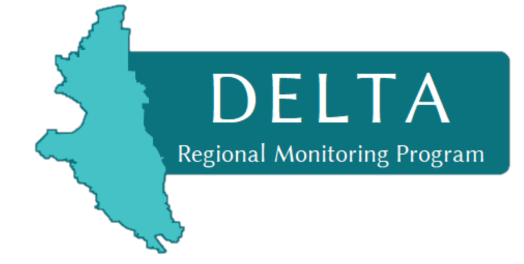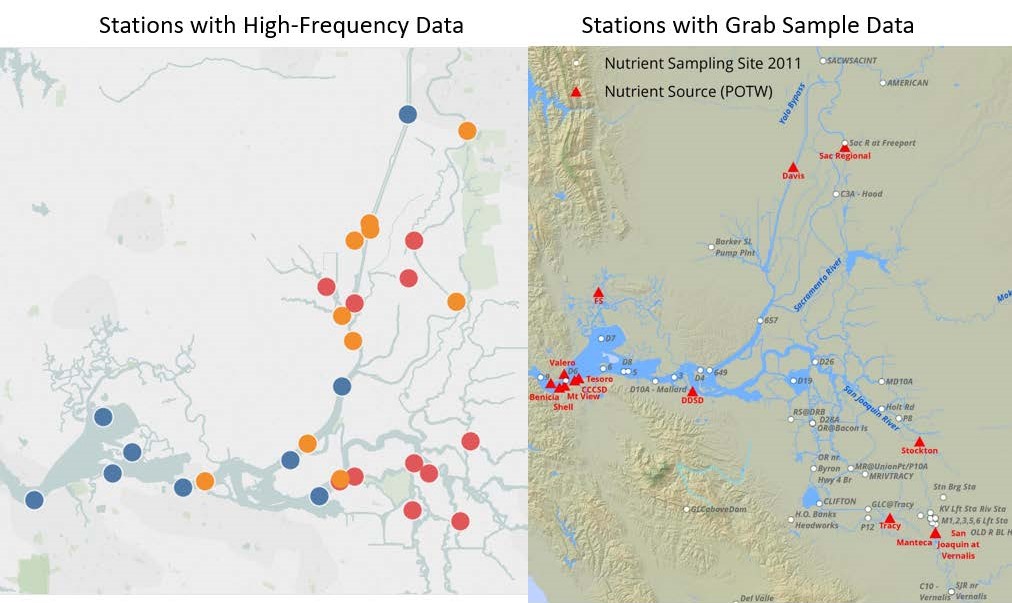the Delta Regional Monitoring Program
Water Quality Monitoring and Studies
Regional monitoring informs management and policy decisions facing the Delta.
The Delta RMP has prioritized the following monitoring sectors for funding data collection and analysis. Explore each tab for more information on the monitoring strategies and published reports.
Monitoring Plan
In 2018-19, the Delta RMP developed a Quality Assurance Program Plan (QAPP) and plan for program implementation of the CEC Pilot Study. Program implementation included optimization of the pilot study work plan, logistics planning, sample collection and analysis vendor selection process administration, contract set-up with vendors, coordination with other monitoring programs, facilitation of the Technical Advisory Committee CEC Subcommittee, and start-up mobilization for 2019-2020 sample collection. Year 1 of this project received funding as a part of a Central Valley Water Board enforcement action.
Monitoring Plan
A multi-year study of current-use pesticides and aquatic toxicity in the Sacramento-San Joaquin Delta began in 2018 (Year 1). A rotating basin monitoring design with monitoring at two fixed sites began in October 2018 and is designed to be a 4-year monitoring program covering six Delta sub-regions. At the end of the monitoring, an interpretive report will inform adaptive management and improve future monitoring. Annual data reports describing the monitoring conducted for the previous water year and associated quality assurance assessment of the data are reviewed by the Delta RMP annually.
Reports
- 2015-2016 Pesticides & Toxicity Monitoring Report
- 2018-2019 Pesticides & Toxicity Monitoring Report*
- 2019-2020 Pesticides & Toxicity Monitoring Report*
- WY 2021 Data Report and Quality Assurance Evaluation
*AHPL’s 2018-2020 midge survival data do not follow the current SWAMP business rule when there are missing organisms or pupae.
- Analysis and Interpretation of Pesticides and Toxicity Monitoring Data in the Sacramento-San Joaquin Delta
Monitoring Plan
Continued monitoring of sport fish and water will address the highest priority information needs related to implementation and revision of the Methylmercury TMDL. Annual monitoring of sport fish will firmly establish baseline concentrations and interannual variation in support of monitoring of long-term trends as a critical performance measure for the TMDL. Monitoring of water on a near-monthly basis will solidify the linkage analysis (the quantitative relationship between methylmercury in water and methylmercury in sport fish) in the TMDL and contribute to verifying trends and patterns predicted by a numerical model of methylmercury transport and cycling being developed for the Delta and Yolo Bypass by the California Department of Water Resources (DWR).
The 8 water sampling event option was selected for 2018-19 monitoring described in the proposal below.
Reports
MONITORING PLAN
Nutrient Multi-Year Study Plan
The Delta Regional Monitoring Program (Delta RMP) developed a Multi-Year Nutrient Study Plan to guide long-term studies of the effects of nutrients on the ecology of the Delta. Three primary questions (also referred to as focus areas) were developed to guide the development of the Study Plan.
- Following a reduction in nutrient loading from different point and nonpoint sources, what ranges of nutrient concentrations are expected to occur throughout the Delta, and how might they be affected by climate change, wetland restorations, and water management and routing?
- What are the thresholds for nutrients (nitrogen (N) and phosphorus (P) and their ratios) that can limit Harmful Algal Bloom (HAB) biomass and cyanotoxin accumulation to safe levels, limit the abundance and distribution of nuisance macrophytes, and support robust growth of desirable phytoplankton and macrophytes throughout the Delta?
- How are the characteristics of harmful cyanobacteria blooms and cyanotoxins in the Delta changing (e.g., species, magnitude, geographic extent, and timing) and what factors contribute to these changes?
The Multi-Year Nutrient Study Plan addresses these three questions or focus areas using a combination of modeling, field/experimental studies, and monitoring. It is not the objective of this Multi-Year Nutrient Study Plan to completely address all three focus area questions. The intent of the studies included in this Study Plan is to begin a multi-year process that begins to address these questions with a hypothesis driven approach and prioritizing data gaps identified by the Steering Committee and Nutrient TAC.
Biogeochemical Model – WY2011 and WY2016
Stations with data that will be used for the modeling analysis. Model verification plots will be made for a subset of these stations covering all areas of the Delta.
Data Synthesis and Modeling
For this study, we propose to combine a hydrodynamic-biogeochemical model of the Delta in WY2016 with water quality measurements in order to understand what caused large phytoplankton blooms in this year. The approach will be to apply a biogeochemical model developed for WY2011 to WY2016 and then to compare the model predictions to measurements made throughout the Delta. Comparisons between the model and observations will provide insight into important mechanisms for phytoplankton productivity including physical and other influencing factors. The study will be a first step toward implementing priority research recommendations in the Delta Nutrient Research Plan. The study design leverages in-kind modeling resources from the Department of Water Resources and takes advantage of studies being funded by other parties. Finally, this project implements a recommendation to increase data sharing among different models and monitoring programs.
Intercalibration Study for Chlorophyll Fluorescence Sensors in the Bay-Delta
Chlorophyll is an important water quality parameter for assessing the effects of nutrients and for fisheries management in the Bay-Delta. This study is the second phase of a multi-year effort to improve the accuracy, precision, and comparability of chlorophyll data collected in the Bay-Delta. Phase I planning has shown that variability in the methods used for measurement chlorophyll across the Bay-Delta is significant and that reducing this variance is of interest to a wide variety of monitoring agencies. In FY18/19, we propose to tackle a portion of the problem with a series of tasks to help understand and reduce the variance in the measurements of chlorophyll by in-situ sensors and laboratory methods. The proposed tasks for 2018 include: (1) assessing methods used by different monitoring programs; (2) performing field intercalibration exercises between programs; (3) organizing a laboratory intercalibration study; and (4) preparing a summary report through technical workgroup discussion. The study leverages in-kind support from the Department of Water Resources and the US Bureau of Reclamation.
- 2018-19 DRMP Nutrients Monitoring – Intercalibration Study Proposal
- San Francisco Estuary Chlorophyll Sensor and Sample Analysis Intercomparison Report
Sacramento River Nutrient Change Study Report
Collaborators of this report included Regional San, Environmental Sciences Associates/Applied Marine Sciences, Estuary and Ocean Science Center at San Francisco State University, U.S. Geological Survey (USGS), and Resource Management Associates.
The Sacramento River Nutrient Change Study (SRiNCS) Report was developed with input from multiple stakeholders involved in the Delta Regional Monitoring Program, as well as the State Water Contractors. The study tracked the effects of changes in nutrient loading resulting from a short-term wastewater effluent diversion at the Sacramento Regional Wastewater Treatment Plant (SRWTP). In the summer of 2019, scheduled wastewater effluent diversions occurred during the Effluent Valve Replacement (EVR) project, part of the EchoWater Project upgrade at the SRWTP. During an EVR diversion in early September 2019, no treated effluent entered the Sacramento River for 48 hours, creating a parcel of “without-wastewater” river water approximately 20 miles (32 km) long. This study observed the magnitudes and impacts of short-term changes in nutrient loading in water with wastewater (WW+, 9/10/19) and without wastewater (WW-, 9/11/19 and 9/12/19) in the Sacramento River and three downstream channels: Georgiana Slough, the North Fork Mokelumne River, and the South Fork Mokelumne River. High resolution boat-based monitoring of water quality complemented and informed the flow modeling efforts and provided an overview of conditions across the study area each day.
The two-year Pathogen Study was completed in April 2017. It was designed to fulfill the dual purpose of characterizing ambient conditions for pathogens (Cryptosporidium and Giardia) throughout the Sacramento-San Joaquin Delta, and satisfying Basin Plan requirements. The study coordinates water agency intake sample collection for the United States Environmental Protection Agency (USEPA) Long Term 2 Enhanced Surface Water Treatment Rule (LT2) between April 2015 and April 2017 with ambient sample collection.
The Delta RMP collected ambient samples at twelve locations through in-kind field support by the Municipal Water Quality Investigations (MWQI) section of the Department of Water Resources (DWR), and in-kind contributions from Workgroup members to oversee sample collection and data assessment. The study was phased to perform a Year 1 assessment of characterization data and then a more targeted Delta subarea evaluation of infectibility, source tracking, hydrodynamics, and decay and growth. However, monitoring results were all below threshold values in the first year and targeted studies were not necessary during the second year.

